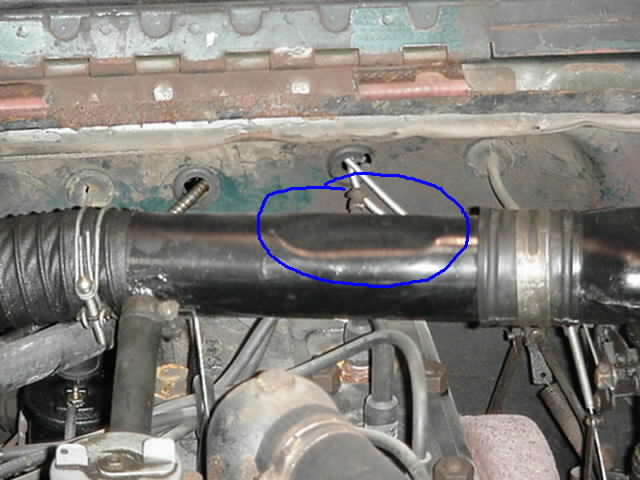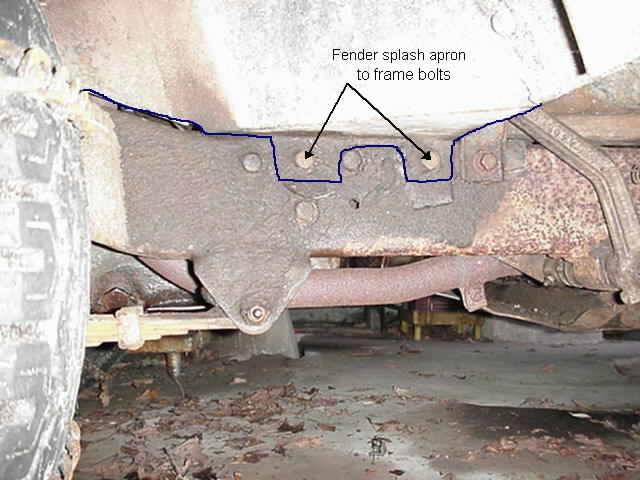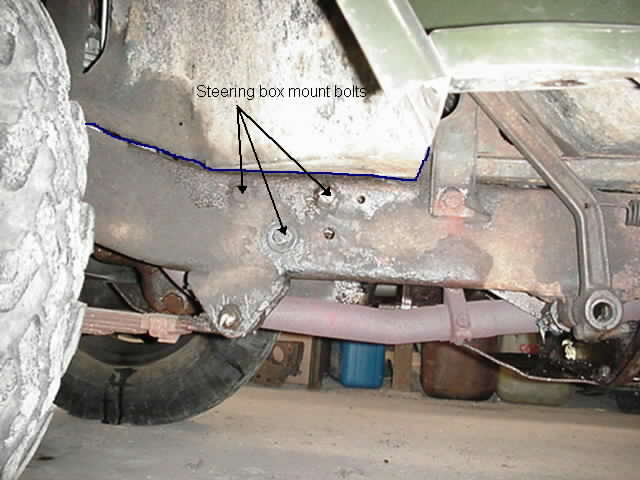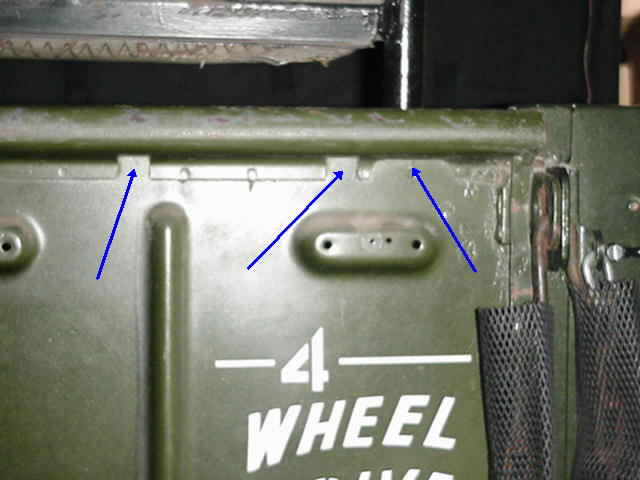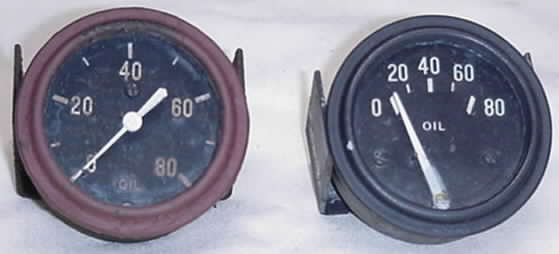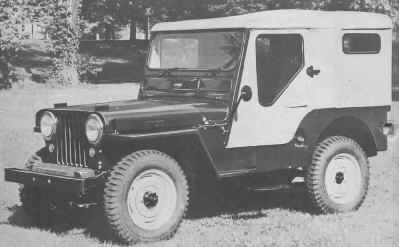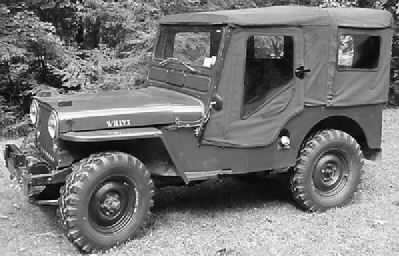Home | Site
Map | Contact Information
____________________________________________________________________________________
Since this article was written
more vehicle changes have come to light. Continued research also
provided more accurate dating. The most current
information can be found in a new book about the CJ-3A.......
The Civilian Jeep Model
CJ-3A
A guide to its features and evolution, 1949 - 1953
See the book's web-page for more information http://cj3a.info/book/index.html
____________________________________________________________________________________
Dating a CJ-3A
The CJ-3A was produced for five model years, 1949 to 1953. Two other
civilian Jeep models overlapped the CJ-3A's production. 1949
was the last year for the CJ-2A and in 1953 the CJ-3B became
available.
Unlike
modern vehicles,
the difference between CJ models was not distinct. The CJ-3A had many
features similar to the late CJ-2As. Likewise the late CJ-3A had some
of the
new characteristics of the CJ-3B. Therefore all CJ-3As are not even the
same. These differences can be used to roughly date when a vehicle was
manufactured. The commonly accepted description of the CJ-3A seems to
apply
only
to the mid production vehicles. The lack of factory parts information
from
the CJ-3A time period makes it very difficult to decide if and when
changes
were made. Much information has been obtained from the CJ-2A and CJ-3A
Parts List (copyright 1949) and the 1945-1949 Master Parts List
(copyright 1955). Many of the listings in the 1945-1949 Parts Master
List are for years later than 1949. Both manuals contain some
errors and omissions. To further complicate things Willys also had a
manufacturing facility in California. Willys Service Bulletin 53-5
explains "the effective serial numbers given apply to changes made in
vehicles assembled at the Toledo plant and do not apply to those
assembled in our west coast plant". The CJ-3As military sibling, the
M38, also went through many changes.
Changes in the M38 seem to parallel a similar change in the CJ-3A with
the military change happening first.
I am collecting information about existing CJ-3As to help determine
when
changes took place. Because anything could have happened to these
vehicles
in the 50+ years since they were manufactured, a large sampling of
vehicles
is necessary to determine which assumptions are valid. From the
information
I have collected to date the following differences are appearing. This
information is preliminary and it changes rapidly as new information is
received from enthusiasts like you. To help by supplying information
about your Jeep, please answer the questions near the bottom of this
page.
Vehicle Serial Numbers The
CJ-2A/CJ-3A Parts Book (copyright 1949) states that the beginning
of production vehicle serial number is 10001 with engine serial number
10001. Vehicle serial number tags are attached with 4 screws to the
engine side
of the firewall near the air filter. The vehicle serial number had a
prefix of CJ-3A for the first 2
years of production. During this time the serial numbers continued to
climb
with no regard for model year. Starting in 1951, and continuing through
final
production, a new format was used. The prefix was changed to indicate
the model and model year and the serial number itself was reset to
10001 at the beginning of each model year. See Willys-Overland
Production Figures 1945-61 on the CJ-3B page for a list of serial
numbers of Willys vehicles.
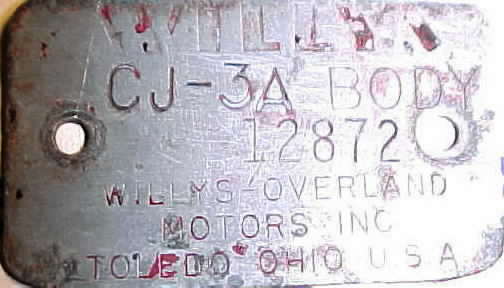 Body Tags The
earliest 1949 CJ-3As have a body number tag below the serial number tag
on the firewall. Later in 1949, and for the remainder of production,
the
body tag was eliminated. Body tag numbers are initially close to the
vehicle serial number and then skew to about 1200 less than the vehicle
serial number. What does this mean? How could there be less bodies than
vehicles? The body tag to the left is from a 1949 CJ-3A, thanks to Andy
Testo for the photo. Early in the 1949 model year Willys began to build
their own
bodies. Prior to
that American Central Manufacturing (ACM) manufactured the bodies.
Body Tags The
earliest 1949 CJ-3As have a body number tag below the serial number tag
on the firewall. Later in 1949, and for the remainder of production,
the
body tag was eliminated. Body tag numbers are initially close to the
vehicle serial number and then skew to about 1200 less than the vehicle
serial number. What does this mean? How could there be less bodies than
vehicles? The body tag to the left is from a 1949 CJ-3A, thanks to Andy
Testo for the photo. Early in the 1949 model year Willys began to build
their own
bodies. Prior to
that American Central Manufacturing (ACM) manufactured the bodies.
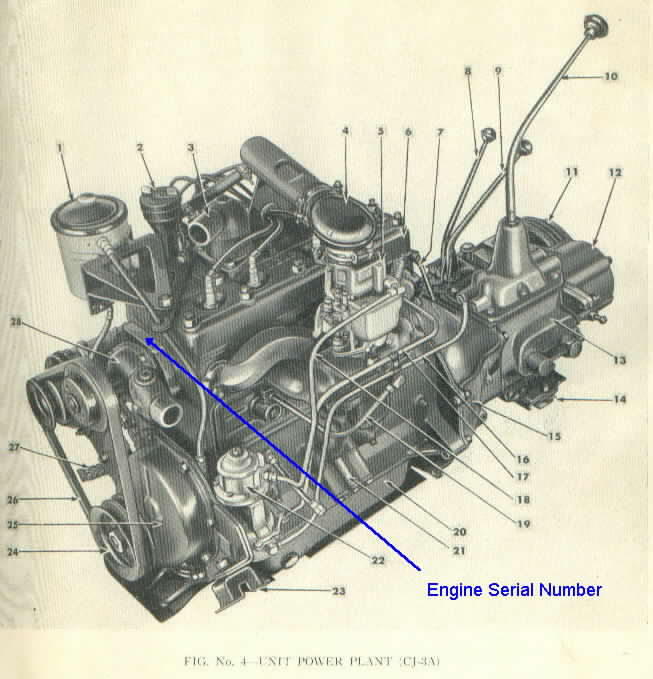 Engine changes
The engine
serial number is stamped on the boss between the water pump and
cylinder head; click on the engine serial number illustration at
the right for the location. The first CJ-3A engine serial number should
be 3J10001 and then
increase through out the remainder of production. Serial number lists
of other models of Willys
vehicles indicate that engine serial numbers increase at a faster rate
than the vehicle serial numbers. This "skew" is probably due to engines
being pulled from stock for other uses, such as replacement engines.
Existing
original CJ-3A engine serial numbers initially increase as expected,
but
then in 1950 and 1951 the skew becomes negative by approximately 2000.
Then in 1952 and 1953 the engine numbers climb again as expected. The
negative
skew would indicate there are fewer engines than vehicles. What caused
the engine serial number difference in 1950 and 1951 to account for a
discrepancy
of several thousand engines? The early engine timing marks are located
on the flywheel and viewed through a small hole in the engine rear
plate. A 1950 service bulletin explains that additional timing marks
will be placed on the front cover and pulley "asap". In
1952 the engine block was changed to one with a larger flange at the
rear.
The 1965 Service Manual states that this was done at engine serial
number
(3J)130859.
The bellhousing was also changed to accept the new larger starter
introduced
here. The early block casting number is 641087 and the late
block casting number is 804380. There are also a few transition blocks
with casting number 641087 and the large flange. Block casting numbers
are found just
above the oil pan on the passenger side. The illustrations below show
the difference between the small and large rear flanges. Below the
drivers side of the engine is shown ,the flanges are similar on the
passenger side of the block.
Engine changes
The engine
serial number is stamped on the boss between the water pump and
cylinder head; click on the engine serial number illustration at
the right for the location. The first CJ-3A engine serial number should
be 3J10001 and then
increase through out the remainder of production. Serial number lists
of other models of Willys
vehicles indicate that engine serial numbers increase at a faster rate
than the vehicle serial numbers. This "skew" is probably due to engines
being pulled from stock for other uses, such as replacement engines.
Existing
original CJ-3A engine serial numbers initially increase as expected,
but
then in 1950 and 1951 the skew becomes negative by approximately 2000.
Then in 1952 and 1953 the engine numbers climb again as expected. The
negative
skew would indicate there are fewer engines than vehicles. What caused
the engine serial number difference in 1950 and 1951 to account for a
discrepancy
of several thousand engines? The early engine timing marks are located
on the flywheel and viewed through a small hole in the engine rear
plate. A 1950 service bulletin explains that additional timing marks
will be placed on the front cover and pulley "asap". In
1952 the engine block was changed to one with a larger flange at the
rear.
The 1965 Service Manual states that this was done at engine serial
number
(3J)130859.
The bellhousing was also changed to accept the new larger starter
introduced
here. The early block casting number is 641087 and the late
block casting number is 804380. There are also a few transition blocks
with casting number 641087 and the large flange. Block casting numbers
are found just
above the oil pan on the passenger side. The illustrations below show
the difference between the small and large rear flanges. Below the
drivers side of the engine is shown ,the flanges are similar on the
passenger side of the block.
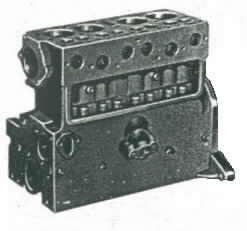
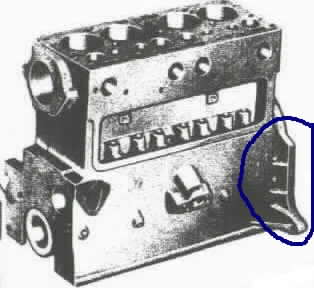
Early small flange
Late large flange
Starters and Generators Starter and generator numbers are
found on a tag that is riveted to their housings. Three different
starters were used. The first vehicles used the Autolite MZ-4137. In
mid 1950 the starter was changed to MZ-4162, according to Autolite
manuals. Willys Service Bulletin #50-31 lists a change in the starter
and starter push rod at vehicle serial number (CJ-3A) 51911 which is in
the 1950 model year. The first
two starters are very similar, are activated by a foot pedal linkage,
open nosed, and use a 124-tooth flywheel. The third starter is Autolite
MCH-6203. This starter is key activated with a solenoid mounted to
the top of the starter and is the closed nose type. It uses a 129-tooth
flywheel. The 1965 Universal Service Manual states that the third
starter was put into production with vehicle serial number 30973 and,
on a different page, engine serial number 130859. By adding the
prefixes 452-GB1 to the vehicle serial number and 3J to the engine
number, the result is vehicle 452-GB1 30973 with engine 3J130859. These
are credible numbers for a 1952 CJ-3A and this data fits perfectly into
the information collected from existing vehicles. The engine block
change to the larger rear flange also occurred at this serial number.
The generator changed from the Autolite GDZ-4817 to Autolite GDZ-6001
during the 1950 model year. Service Bulletin #50-31 states a different
engine front plate was implemented at engine (3J)50551 for the new type
generator and the new
generator actually entered production at vehicle number (CJ-3A) 51951.
Then
in 1953 at vehicle serial number 453-GB1 17807 the generator and
regulators were changed again to provide a greater output. According to
Service Bulletin 53-5 this generator provided a nominal 45 amp
output. This last generator may have been an Autolite GGW-4801 or
GGW-7404. Thanks to Bill Norris for a copy of the Bulletin.
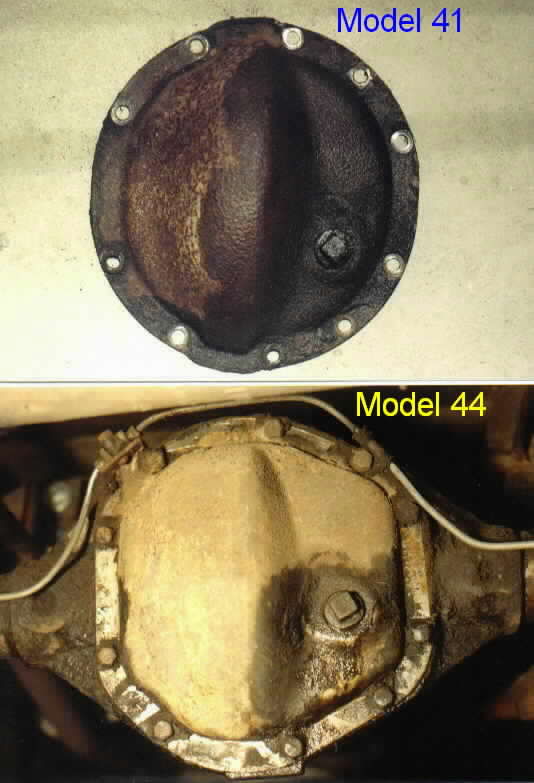 Axles and
Driveshafts One of
the common improvements associated with the
CJ-3A is the model 44 rear axle. The model 41 axle was actually used in
the 3A until the end of the 1950 model year. The 1945-49 Master Parts
List
(copyright 1955) lists this change at vehicle serial number (CJ-3A)
62488 (very
late 1950 model
year). On the Classic Willys Message List Todd Paisley stated that
Engineering Release #6427 Rear Axles (Spicer) - Change from Spicer
Model 41 to Model 44 was started on October 31, 1950 and and
implemented on November 30, 1950. The rear axle can be identified by
the shape of the differential cover (see photos at left). The model 41
axle
uses
a round differential cover while the model 44 cover has straight sides.
Axles and
Driveshafts One of
the common improvements associated with the
CJ-3A is the model 44 rear axle. The model 41 axle was actually used in
the 3A until the end of the 1950 model year. The 1945-49 Master Parts
List
(copyright 1955) lists this change at vehicle serial number (CJ-3A)
62488 (very
late 1950 model
year). On the Classic Willys Message List Todd Paisley stated that
Engineering Release #6427 Rear Axles (Spicer) - Change from Spicer
Model 41 to Model 44 was started on October 31, 1950 and and
implemented on November 30, 1950. The rear axle can be identified by
the shape of the differential cover (see photos at left). The model 41
axle
uses
a round differential cover while the model 44 cover has straight sides.
A larger diameter rear driveshaft appeared at about the same time as
the
rear axle change. Early CJ-3As used a 1-1/4" diameter rear driveshaft
while
the later 3As used a 1-3/4" diameter rear driveshaft. I have not been
able to pinpoint when the change was made because during the 1951
model year I am seeing both small and large diameter driveshafts
randomly. By 1952 all driveshafts are large diameter. The rear
driveshaft on the M38, the CJ-3As military equivalent, was changed from
1-1/4" to 1-3/4" diameter on 1/5/51 according to postings on The G503 Message Forums.
Transmission and Transfer Case Shifters "The shape of the
transmission shift lever was changed and the length was increased one
inch on the transmission and five inches on the transfer case to
provide easier shifting and better clearances on the Model CJ-3A
transmission beginning with Vehicle Serial No. 18829" and "in
production on the transfer case beginning with Model CJ-3A Serial No.
21712" according to Service Bulletin 49-34. Both serial numbers are
early in the 1949 model year. The early shifters can be seen in the
engine serial number location illustration above. The late transmission
shifter had
a straight shaft with a low sharp bend. Late transfer case front axle
engagement shifters were longer than the high-neutral-low range shifter.
Radiator The first CJ-3As utilized a bottom-mounted radiator,
like the 2As. The bottom of this radiator was bolted to the frame
crossmember
and had a rod that extended between the bracket on the radiator top
tank
and the firewall. Later CJ-3A radiators were side mounted. The side
mount radiator was bolted to the
grill on both sides instead of the frame, and lacked the top connecting
rod. The last bottom mounted radiator was CJ-3A 21656, according to the
1945-49
Master Parts list (copyright 1955). Service Bulletin No. 49-57 lists
this change at a different serial number, CJ-3A 31374. Keith
Buckley also added that the Air Deflector portion of the grille changed
from 22 gage to 18 gage at this time. This logically was done to
support the extra weight of the radiator. The vehicle frame also
changed as the two radiator mount tabs were eliminated with the side
mount radiator. Surveys of existing vehicles
indicate that the CJ-3A 21656 serial number is most likely the correct
point of change. Existing vehicles also show the possibility
of a short run of bottom mounted radiators after the side mounted
radiator had been put into production. It is interesting that Service
Bulletin 50-4, Installation of Monroe Hydraulic Lift Pump on Models
CJ-2A and CJ-3A, mentions "During the production of the Model CJ-3A
with the side mount radiator, it was necessary to use a small quantity
of bottom mounted radiators".
Air Inlet The large majority of
existing 1949 CJ-3As surveyed have Oakes manufactured air filters. Most
1950 and newer vehicles have Donaldson air filters. The Oakes air
filter has a flat top while the Donaldson air filter top is dome
shaped. At serial number (CJ-3A) 62692 the Air Cleaner Tube and Bracket
was changed according to the 1945-1949 Master Parts List
(copyright 1955). The new "crossover tube" did not have a dimple in the
top which was previously needed for clearance between the tube and the
top radiator support rod. The photo below illustrates the early tube,
with a dimple, in a CJ-3A without the radiator support rod.
Hood On early CJ-3As the location of the hood blocks is
not equidistant from
the hood center seam. This is a leftover characteristic of the CJ-2A.
Service Bulletin
51-4 explains that "the right hand hood bumper has been relocated an
equal distance on the right hood side, as compared to the left hood
side for better appearance. This change was made effective with serial
number (451-GB1) 13783".
Left Front Fender The
left (drivers side) front fender attachment on early 3As had additional
bolts holding
the splash apron to the frame. The 1945-1949 Master Parts List
(copyright 1955) indicates that two 3/8"-24 x 3/4" bolts, washers and
lock washers for attaching the left front fender to the frame were only
used up to Serial No. (CJ-3A) 62505. This serial number would fall very
late in the 1950 model year. The fenders also changed eliminating the
extra flange with the bolt holes. The fender part number did not change
possibly because both types of fenders could be interchanged. Later
vehicle
frames are also different as the threaded holes for the fender splash
apron bolts were eliminated.
Early and late style left fenders, click on photos for a larger view
Tailgate
A minor change was made to the tailgate in mid 1951. The M38, a sibling
of the CJ-3A, required four cutouts in the top flange of the tailgate
to allow for rear seat bracket and spare tire carrier attachment. This
modified part carried over to the civilian Jeep although it was not
necessary on the CJ. The photo below shows a late tailgate with 3 of
the 4 cutouts visible. The 4th cutout is the longer oval type on the
far left side of the tailgate. See the excellent article,
Tailgate
Reading, on the CJ-3B Page for more information about tailgates.
Tail Lights Late in the 1950 model year, at serial number CJ-3A
53768, the rear tail light changed from steel stamping to zinc die
casting according to Service Bulletin 50-40. NACO tail lights were
steel stampings and ALA tail lights were zinc die castings. There is a
good
article on The CJ-3B Page that shows all the
different CJ tail lights.
Horn Button Horn buttons change from the button inside
the
steering
wheel nut to the rubber cover over the nut type. This was done to make
it more waterproof. The change is
appearing at approximately the same time as the 1950 to 1951 model year
change. The 1945-49 part book lists this change at vehicle serial
number (CJ-3A) 57215. Surveys of actual vehicles show that both types
of
buttons were used into 1951. The rubber cover is often missing
from the late style since the rubber deteriorates over the years.
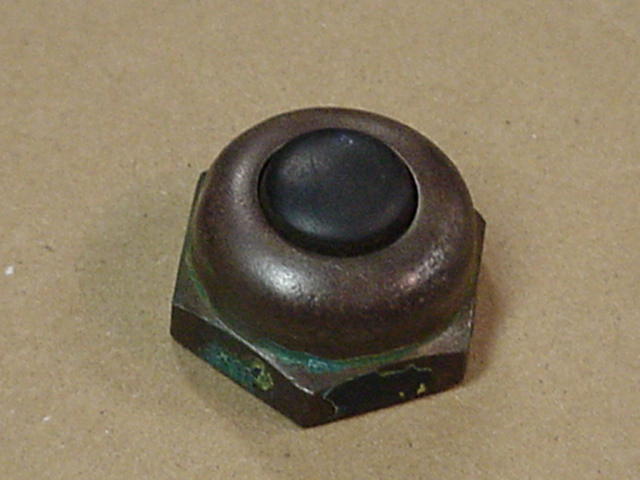
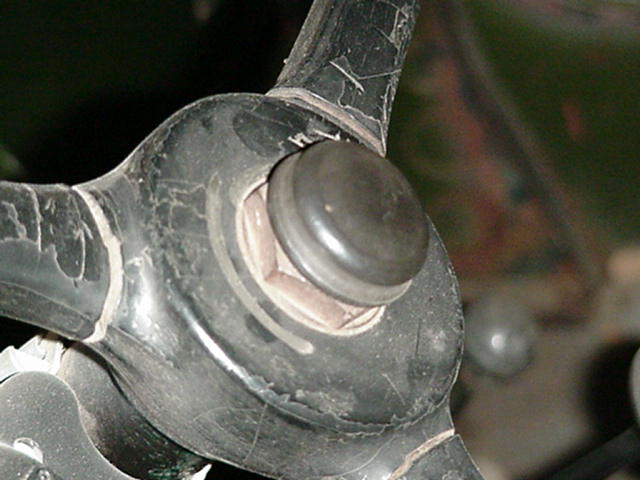
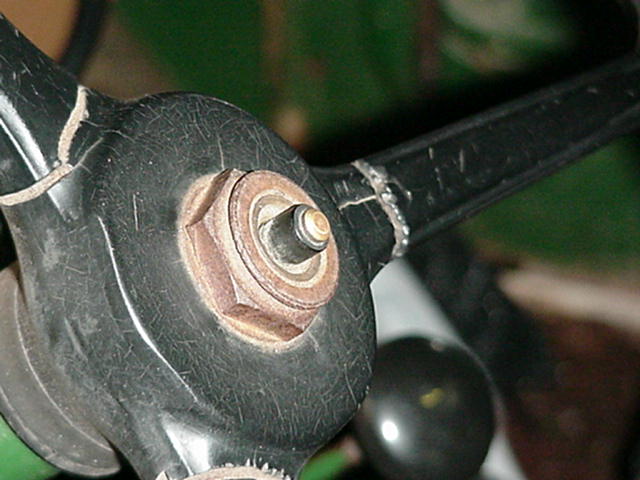
Early horn button inside
nut
Late button with rubber
cover Late
style with cover missing
Gauges According
to Service Bulletin 50-8 the temperature and oil pressure gauges style
changed at serial number (CJ-3A) 43699 in the 1950 model year. The
"dial" type was superseded by the "lever" type gauges.
Early "dial" and Late "lever" oil pressure gauges
Canvas Body Top Willys parts
manual illustrations show the CJ-3A with a 7 piece canvas top and small
metal framed windows similar to the CJ-2A. The 1945-49 parts book
(copyright 1955) states there is a "New front top kit with larger
curtain lights and eliminating window frames. New door assemblies and
side curtains may be serviced for the old type with smaller windows in
pairs only." According to Service Bulletin 50-14 the window change was
made at (CJ-3A) 46180 which would be just after mid 1950. The door
frames were also changed to make room for the larger windows. This was
done by relocating the diagonal brace from above the door handle to
below it.
Early small window top with metal frames
Late large
window canvas top
Colors The first CJ-3A windshield frames were painted the
body color. Most original vehicles after mid 1952 seem to have
black
windshield frames instead of body color windshield frames. This is
consistent
with the CJ-3B, which had black windshield frames. This change appears
at about vehicle serial number 452-GB1 20000.
Original
wheel colors are
difficult
to find. The wheels on many vehicles have been replaced since wheels
are
easily exchanged. The "Gray
Jeep" as seen on the CJ-3B Page has reddish
orange wheels (Sunset Red?) so we can assume that in 1951 there were
several
different wheel colors depending on the body color. Did the last 3As
use just black or white wheels like the later CJs?
From the G503 CJ Technical Knowledge Base comes this information;
Engineering Release #5248 Gas Tank
Assey. (Painted Black) - Revise Paint Spec. From body Color to black
Enamel started on 1/27/49 and issued 2/15/49. This indicates that
the early 1949s had body colored fuel tanks. The change to black fuel
tanks may have occurred at about the same time as the body serial
number tag
was eliminated.
Other Minor Changes
Click here for a list of other minor
changes that were made to the
CJ-3A.
I would like to thank everyone who has helped by providing
information. There are far too many people to name. All the people who
took the time to provide data about their CJ-3A deserve credit as this
couldn't be done without them. Special thanks to Harold West for help
with the data and ideas about how to analyze the information.
More data is needed to confirm these findings. Much of this
information does
not seem to be written down anywhere so your input is very important to
document the changes. If you own a CJ-3A, or have any information about
the 3As, please fill out the following survey and e-mail it to me. The
answers to any of the questions are helpful even if your Jeep has been
modified or you can not answer all the questions.
Your input can help record the history of the 3A.
All comments are welcome
Bob Westerman
Click here for contact information.
Willys CJ-3A Questions
Please answer the questions as your Jeep was originally equipped.
1. Owner Name
2. What is the model year of the Jeep?
3. What is the original body color?
4. What is the original color of the windshield frame?
5. What is the original color of the wheels?
6. What is the original color of the gas tank?
7. Original soft top color, bow color and window size?
8. Are the hood blocks located equal distance from the hood center
seam?
9. Does the tailgate top flange have cutouts? (see photo above)
10. Oil and temperature gauges, dial or lever type? (see photos above)
11. Is the horn button bakelite inside the steering wheel nut or a
rubber
cover over the nut?
The rubber cover is often missing. (see photos above)
12. Does a push rod pedal, floor switch, dash button, or key activate
the starter?
13.
Are the transfer case shifters approx. the same height or is the front
drive lever taller?
14. Does the transmission shifter have a bend in the middle or is it
straight with the bend at the bottom?
15. Is the radiator side mount (grille mounted) or bottom mount (frame
mounted)?
16. What is the vehicle serial number? (located on the tag screwed
to the firewall near the air filter)
17. Is there a body tag, or holes for a tag, below the serial number
tag? If so what is the body Number?
18. What is the engine serial number? (stamped on the boss between the
water pump and cylinder head)
19. Is there a dimple in the air filter crossover pipe? (see photo
above)
20. Does the air filter have a flat or dome shaped top?
21. Generator part #
22. Regulator part #.
23. Distributor part #
24. Starter part #
25. Does the engine block have the late large flange at rear of block?
(see illustrations above)
26. What is the engine casting number? (passenger side just above the
oil pan)
27. Is the rear axle a model 41 or model 44? (41 round cover, 44
straight
sides)
28. Rear driveshaft small diameter (1-1/4") or large diameter (1-3/4")?
(The front driveshaft is always 1-1/4" for comparison)
29. Left front fender splash apron bolted to frame? (see photos above)
30. Overall, is the vehicle original or modified on a scale of 1-10
with 10 being original?
Click here for contact information.
 Body Tags The
earliest 1949 CJ-3As have a body number tag below the serial number tag
on the firewall. Later in 1949, and for the remainder of production,
the
body tag was eliminated. Body tag numbers are initially close to the
vehicle serial number and then skew to about 1200 less than the vehicle
serial number. What does this mean? How could there be less bodies than
vehicles? The body tag to the left is from a 1949 CJ-3A, thanks to Andy
Testo for the photo. Early in the 1949 model year Willys began to build
their own
bodies. Prior to
that American Central Manufacturing (ACM) manufactured the bodies.
Body Tags The
earliest 1949 CJ-3As have a body number tag below the serial number tag
on the firewall. Later in 1949, and for the remainder of production,
the
body tag was eliminated. Body tag numbers are initially close to the
vehicle serial number and then skew to about 1200 less than the vehicle
serial number. What does this mean? How could there be less bodies than
vehicles? The body tag to the left is from a 1949 CJ-3A, thanks to Andy
Testo for the photo. Early in the 1949 model year Willys began to build
their own
bodies. Prior to
that American Central Manufacturing (ACM) manufactured the bodies.  Engine changes
The engine
serial number is stamped on the boss between the water pump and
cylinder head; click on the engine serial number illustration at
the right for the location. The first CJ-3A engine serial number should
be 3J10001 and then
increase through out the remainder of production. Serial number lists
of other models of Willys
vehicles indicate that engine serial numbers increase at a faster rate
than the vehicle serial numbers. This "skew" is probably due to engines
being pulled from stock for other uses, such as replacement engines.
Existing
original CJ-3A engine serial numbers initially increase as expected,
but
then in 1950 and 1951 the skew becomes negative by approximately 2000.
Then in 1952 and 1953 the engine numbers climb again as expected. The
negative
skew would indicate there are fewer engines than vehicles. What caused
the engine serial number difference in 1950 and 1951 to account for a
discrepancy
of several thousand engines? The early engine timing marks are located
on the flywheel and viewed through a small hole in the engine rear
plate. A 1950 service bulletin explains that additional timing marks
will be placed on the front cover and pulley "asap". In
1952 the engine block was changed to one with a larger flange at the
rear.
The 1965 Service Manual states that this was done at engine serial
number
(3J)130859.
The bellhousing was also changed to accept the new larger starter
introduced
here. The early block casting number is 641087 and the late
block casting number is 804380. There are also a few transition blocks
with casting number 641087 and the large flange. Block casting numbers
are found just
above the oil pan on the passenger side. The illustrations below show
the difference between the small and large rear flanges. Below the
drivers side of the engine is shown ,the flanges are similar on the
passenger side of the block.
Engine changes
The engine
serial number is stamped on the boss between the water pump and
cylinder head; click on the engine serial number illustration at
the right for the location. The first CJ-3A engine serial number should
be 3J10001 and then
increase through out the remainder of production. Serial number lists
of other models of Willys
vehicles indicate that engine serial numbers increase at a faster rate
than the vehicle serial numbers. This "skew" is probably due to engines
being pulled from stock for other uses, such as replacement engines.
Existing
original CJ-3A engine serial numbers initially increase as expected,
but
then in 1950 and 1951 the skew becomes negative by approximately 2000.
Then in 1952 and 1953 the engine numbers climb again as expected. The
negative
skew would indicate there are fewer engines than vehicles. What caused
the engine serial number difference in 1950 and 1951 to account for a
discrepancy
of several thousand engines? The early engine timing marks are located
on the flywheel and viewed through a small hole in the engine rear
plate. A 1950 service bulletin explains that additional timing marks
will be placed on the front cover and pulley "asap". In
1952 the engine block was changed to one with a larger flange at the
rear.
The 1965 Service Manual states that this was done at engine serial
number
(3J)130859.
The bellhousing was also changed to accept the new larger starter
introduced
here. The early block casting number is 641087 and the late
block casting number is 804380. There are also a few transition blocks
with casting number 641087 and the large flange. Block casting numbers
are found just
above the oil pan on the passenger side. The illustrations below show
the difference between the small and large rear flanges. Below the
drivers side of the engine is shown ,the flanges are similar on the
passenger side of the block.

 Axles and
Driveshafts One of
the common improvements associated with the
CJ-3A is the model 44 rear axle. The model 41 axle was actually used in
the 3A until the end of the 1950 model year. The 1945-49 Master Parts
List
(copyright 1955) lists this change at vehicle serial number (CJ-3A)
62488 (very
late 1950 model
year). On the Classic Willys Message List Todd Paisley stated that
Engineering Release #6427 Rear Axles (Spicer) - Change from Spicer
Model 41 to Model 44 was started on October 31, 1950 and and
implemented on November 30, 1950. The rear axle can be identified by
the shape of the differential cover (see photos at left). The model 41
axle
uses
a round differential cover while the model 44 cover has straight sides.
Axles and
Driveshafts One of
the common improvements associated with the
CJ-3A is the model 44 rear axle. The model 41 axle was actually used in
the 3A until the end of the 1950 model year. The 1945-49 Master Parts
List
(copyright 1955) lists this change at vehicle serial number (CJ-3A)
62488 (very
late 1950 model
year). On the Classic Willys Message List Todd Paisley stated that
Engineering Release #6427 Rear Axles (Spicer) - Change from Spicer
Model 41 to Model 44 was started on October 31, 1950 and and
implemented on November 30, 1950. The rear axle can be identified by
the shape of the differential cover (see photos at left). The model 41
axle
uses
a round differential cover while the model 44 cover has straight sides.
